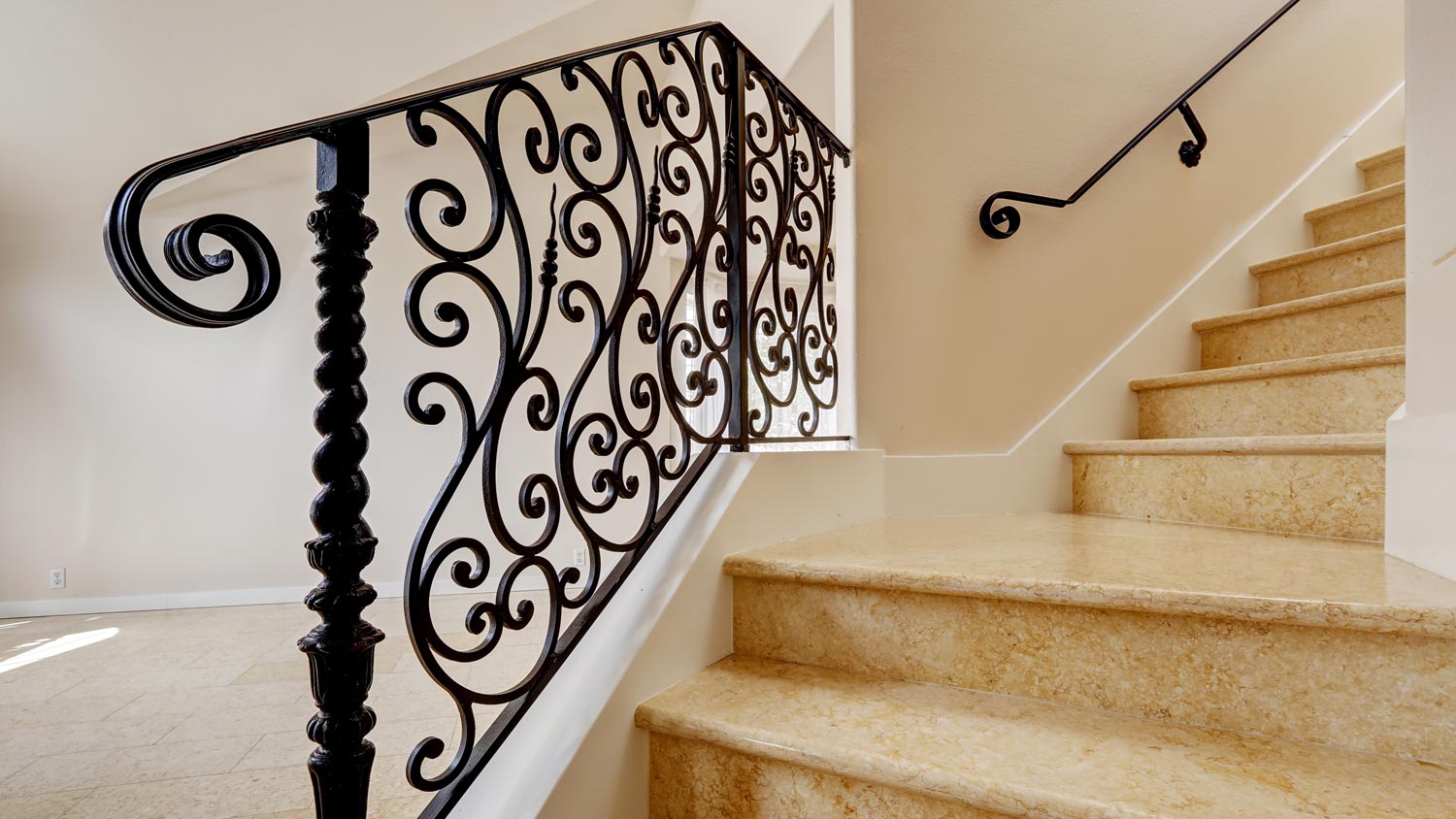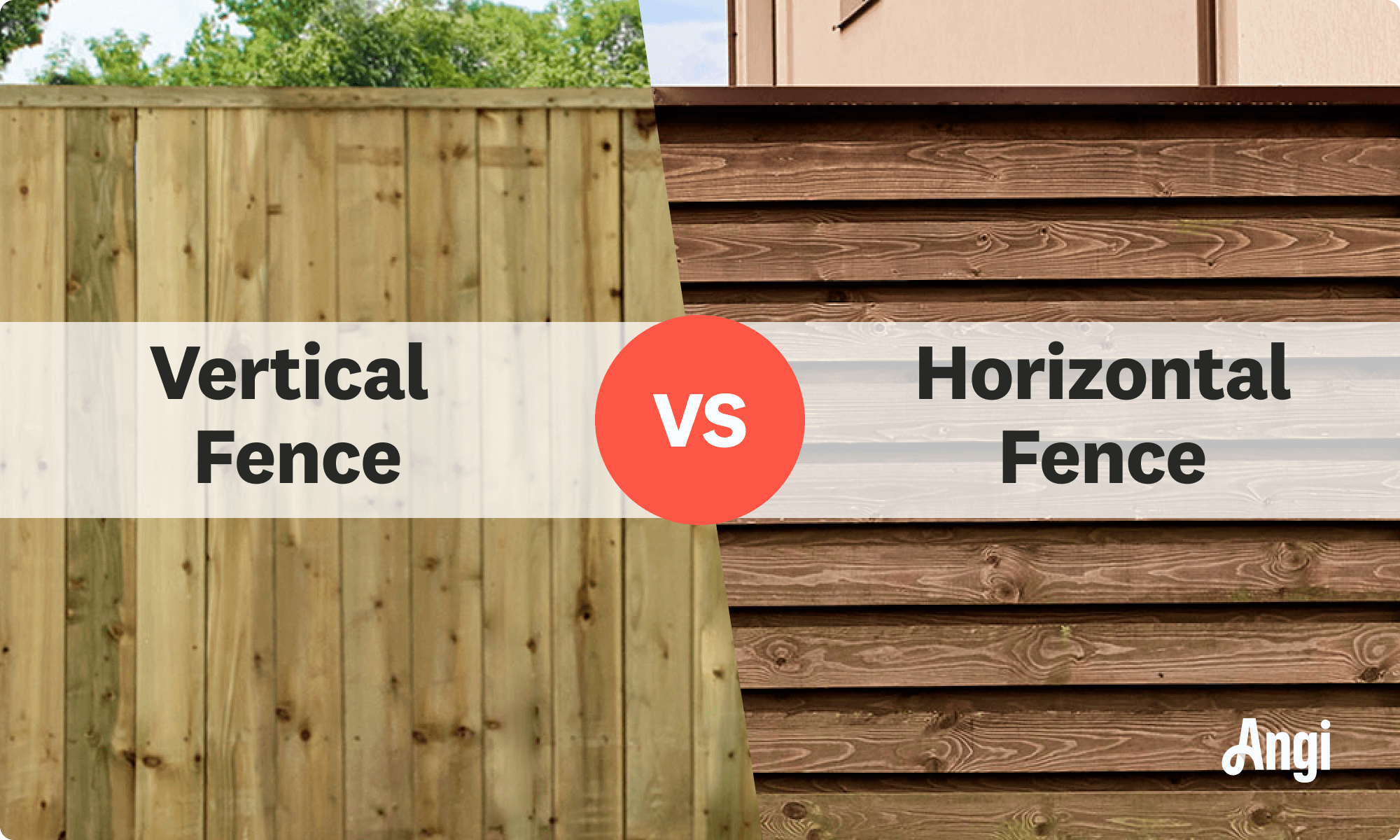
Get expert insights on wrought iron railing repair cost, including average prices, key cost factors, and tips to save on your next project.
Don’t fence yourself in—explore both options


Horizontal fences are more unique, but pricier.
Vertical fences are considered more traditional.
For an easier installation, choose vertical fencing.
If you have a sloped yard, vertical fencing is the best option.
Whether you have a dog running around or want to add some privacy to your yard, a fence is a great option. Before diving into the different types of fences or finding a local fence contractor, you must first decide if you want your fence boards to run horizontally or vertically.
While it may seem like a small decision, it has a big impact on the cost and appearance of your final product. Let’s compare horizontal vs. vertical fences to see which is right for your backyard remodeling project.
Horizontal fences are often stronger than vertical fences because they require higher-grade lumber, but they are more expensive to install. Vertical fences offer an easier DIY job and lower-cost installation on average, but they aren’t as durable as horizontal fences.

Unlike traditional vertical fences, horizontal fences feature pickets that run parallel to the ground, or from side to side.
| Pros | Cons |
|---|---|
| Unique design | More expensive |
| Features strong lumber | On-site installation |
| Durable against elements | Less home security |
Best for:
Modern or contemporary homes
Homeowners who aren’t too concerned about privacy
Properties with a home security system
Homes located in regions prone to inclement weather
Big-budget projects
One of the most appealing perks of a horizontal fence is its unique design. Traditional fences are vertical, so choosing a horizontal design will make your home stand out in the neighborhood. Horizontal fences are also stronger than their vertical counterparts since they require higher-grade lumber. The durability of their material means less weather impact because ground moisture doesn’t affect the ends of the pickets.
Ask your fence installation pro about the benefits and drawbacks of horizontal and vertical fences for your property. If you want wider board spacing with a sleek look, they might suggest a horizontal fence since vertical stringers would be visible with wider spacing.
One notable downside to horizontal fences is that they’re more expensive than vertical fences. That’s because they must be bought piece by piece. Since you can’t buy horizontal fences in packs, you or your fencing pro will have to build a horizontal fence on-site, which adds to fence installation costs.
The design of horizontal fences makes them less secure than vertical fences, because their ladder-like slats can allow trespassers to scale the structure more easily. Even at its tightest, horizontal fences leave a 1/8-inch gap between boards. While it may not seem much, it’s enough to see through, so there’s not as much privacy.

Vertical fences are more traditional and feature boards or pickets that run from the ground up.
| Pros | Cons |
|---|---|
| Less expensive | Less modern and unique |
| Easier installation | May sag in some areas |
| Works on uneven ground | Less durable lumber |
| Increased privacy and security | Deteriorates more quickly |
Best for:
Older, traditional homes, such as an American Colonial-style
Homeowners working with a smaller budget
Properties with sloped or uneven terrain
Locations with dry weather
One of the biggest perks of a vertical fence is its price. Vertical fences cost less than horizontal fences because they are made from less expensive wood and can be assembled off-site. Vertical fence packs are designed to be efficiently assembled during installation. For this reason, vertical fences are the best bet for a DIY fence project.
These types of fences also work well on uneven ground. You can stagger vertical fence packs, even on a steep slope. And much like horizontal fences, vertical fences are also quite sturdy. Their weight is evenly distributed and they have horizontal stringers installed to reinforce that sturdiness, as well.
Finally, vertical fences make better privacy fences and offer more security than horizontal fences, since the boards are closer together and not easy to climb.
One of the drawbacks of a vertical fence is that it doesn’t have as much aesthetic value or stand out as much as a horizontal fence. But for some homeowners who prefer a traditional look, this can actually be a perk. Another con is that vertical fences are more impacted by severe weather. The most sensitive part of a fence is its ends, which in the case of a vertical fence face up toward the sun and elements and down into the ground. This means vertical fences deteriorate faster over time in areas with more moisture. They can also be prone to sagging.

Now, let’s take a look at which fence comes out on top for appearance, durability, security, and more.
There aren’t many people who will say that a vertical fence is more attractive than a horizontal one. Horizontal fences are sleek, modern, and unique—giving your home a standout look in the neighborhood. And if your home already has a modern design, a vertical fence will likely stand out as well (but in the wrong way).
Horizontal fences must be installed on fairly level ground, so they’re a little less flexible regarding where you can install them. If your back or front yard is sloped, you’ll likely have to resort to a vertical fence—regardless of your design preference.
Horizontal fences are prone to sagging if not reinforced with posts or cross beams. But they’re made from higher-grade lumber than traditional vertical fences. That said, vertical fences already include reinforcements that make them very durable. So when trying to decide which is more durable, it's not black and white.
Even at their tightest, horizontal fences leave enough of a gap between slats that someone can look through. These gaps also give someone enough leverage to climb your fence easier than if the posts were vertical. So if you’re looking for a fully private solution, vertical fences are your best bet.
Most of the time, vertical fences are more affordable than horizontal ones for a few reasons. For example, vertical fences are made from less expensive wood and are sold in pre-made packs while horizontal fences are taller and must be installed on-site. While many other factors are at play, it’s safe to say a horizontal fence will cost you more.
Vertical fences are created so that very handy homeowners can install them on their own. That’s not to say it isn’t a big job, because it is. But horizontal fence installation requires more experience and expertise and is best left to a local fence contractor near you.
The most susceptible parts of a fence are the exposed ends. And with vertical fences, those ends are facing upward (toward the sun, rain, snow, etc.) and down into the ground (which gets wet or has bugs). So if you live in an area with higher moisture levels, your vertical fence will wear out faster.
Installing a fence offers up to a 70% return on investment (ROI), but it’s hard to tell which type of fence has the biggest impact. A fence made from higher-quality materials and with a unique design will likely have the best ROI. But, either one is good from a resale value.
Did an absolutely amazing and fantastic job. I wish I had a before picture but I just have this after one. For perspective, there was a weedy, sapling filled jungle on this backyard reaching up to the fence in some spots. It only took Miguel two visits to take the jungle back. Will 100% be...
Without a doubt, this company is highly recommended, a quick response, an excellent job, very professional, they renovated my fence in a single day, it was like new, very satisfied with the result, thank you
Devin came out the same day to check out a tree that had fallen in the fence line of our horse pasture. He was quick with the job and did an outstanding job cleaning up! Cant even tell a tree was there. Highly recommend him for future jobs. Will definitely use again
He was very efficient, with the time allotted to complete the project at hand. He understood the assignment and his execution was flawless. Will definitely book again the assembly and carpet install was greatly appreciated
Got the job done quick for a fair price. Great guy. Honest and on time.
They did a great job. The only problem I had with them was we were scheduled for 1- 4pm that day, they had some sort of work emergency, they ended up getting to us at around 6pm . They stayed in touch with me the entire time until they arrived at our home. We will totally use them again to...
I can always count on Jason and he will reply back in a timely manner to set up appointments and get the work done, I have hired him for multiple things like moving, clearing snow from walkways and driveways, power washing, painting, replace fencing, replacing sink faucet and I have been very...
They are highly professional and oriented toward the customer. They are conscientious about their work and strive to please their customers. They replaced a fence for us and I couldn't ask for a better experience.
The fence is working great and I m glad I did this rather than fencing my yard.
Removed weeds and volunteer trees from fence line. Removed weeds from landscaping. Cleaned gutters. Just general yard clean-up.
From average costs to expert advice, get all the answers you need to get your job done.

Get expert insights on wrought iron railing repair cost, including average prices, key cost factors, and tips to save on your next project.

The cost of a barbed wire fence depends mainly on how large your property is. If you have a longer fence, you can expect to pay a few thousand dollars.

Installing a redwood fence costs around $6,300, though several factors, such as size, landscaping, and permits, can impact the price.

If you’re struggling to choose the right type of fence post for your yard, keep reading for a breakdown of fence post foam vs. concrete options.

Wondering how to fix a rotted end on a fence gate? Your best bet is to replace the entire post. This step-by-step guide walks you through that process.

Explore 5 common types of chain-link fences: galvanized, vinyl-coated, privacy, mini-mesh, and security. Find the perfect fit for your property needs.